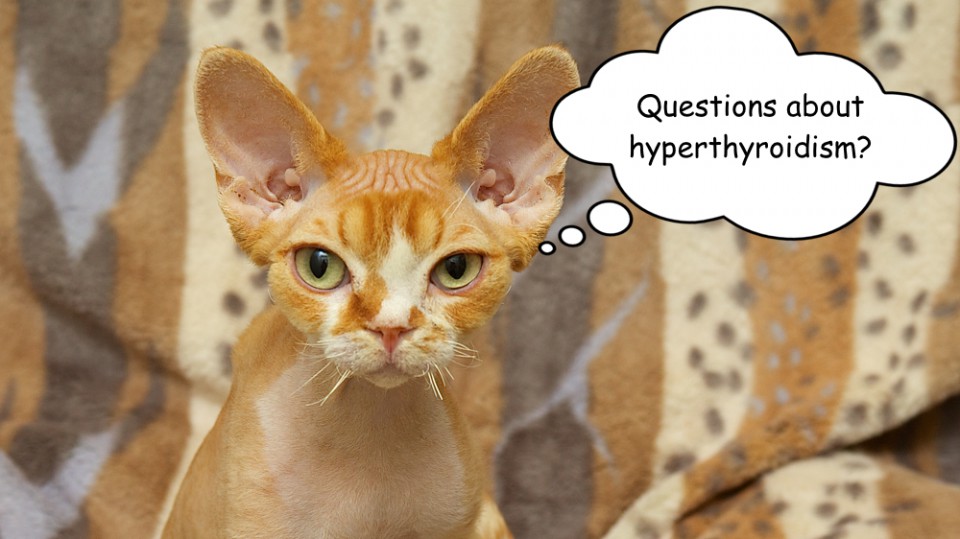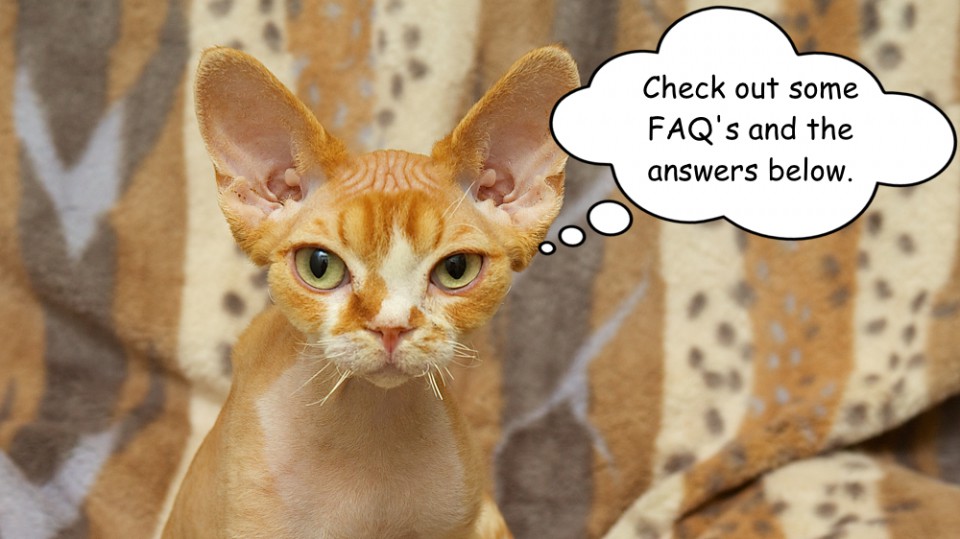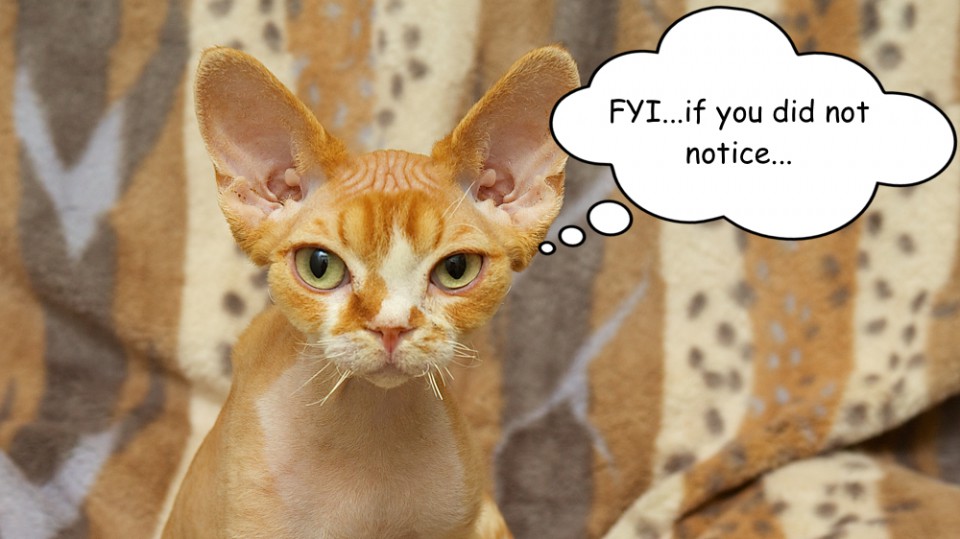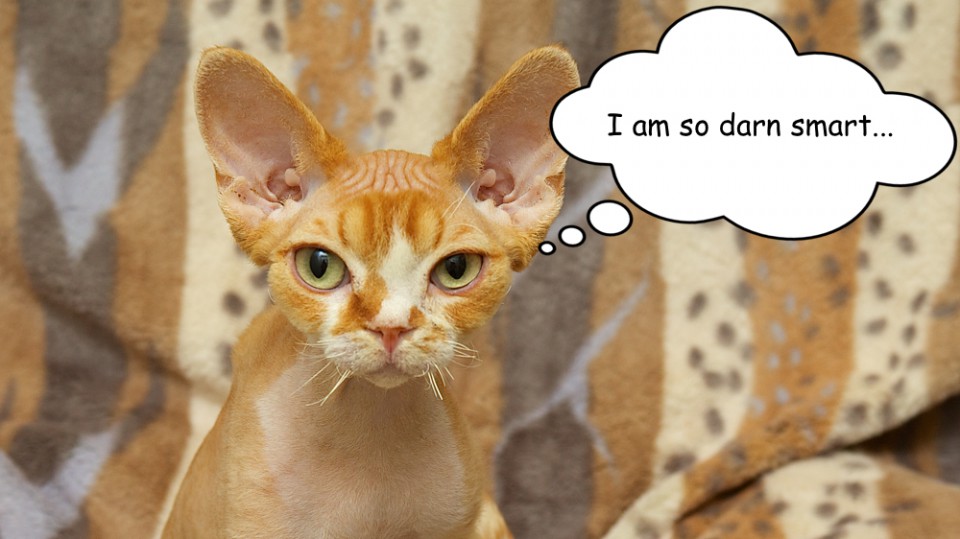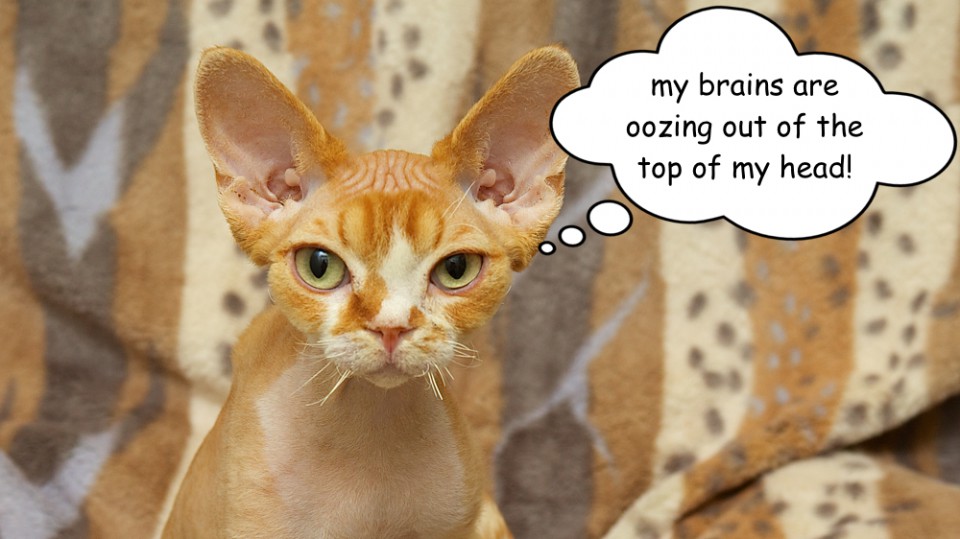Hyperthyroidism
What causes hyperthyroidism in cats?
What are the options for treating cats with hyperthyroidism?
A.) Medical – Cats with hyperthyroidism can be given pills called methimazole (brand name = Tapazole®). Tapazole® works by suppressing the thyroid gland’s production of thyroid hormone. It does not eliminate the thyroid tumor that causes hyperthyroidism nor does it slow the continued growth of the tumor.
B.) Surgical – Cats with hyperthyroidism can be treated by surgical removal of the thyroid tumor responsible for the disease. Unfortunately, this generally requires the removal of the entire thyroid gland, necessitating the chronic administration of thyroid supplements for the remainder of the cat’s life. Surgery also has other negatives including the risk of anesthesia, and probable damage to small glands attached to the thyroid gland called the parathyroid glands. These parathyroid glands are responsible for calcium balance in the body and damage to them can lead to low calcium levels, seizures, and even death.
C.) Dietary – (Iodine-deficient diet Hills Prescription Diet y/d) – Thyroid hormone production requires 2 essential ingredients from our diet, namely the amino acid tyrosine and the essential mineral iodine. A diet sufficiently deficient in the essential mineral iodine will reduce the amount of thyroid hormone that can be produced by the small benign tumors that cause hyperthyroidism. Unfortunately, the diet must be fed exclusively with no other food source available to the cat. Any commercially available cat food and most human foods are replete with iodine and a single meal will undermine the value of the iodine deficient diet for up to a week or more. Like the medical option (methimazole) described above, an iodine-deficient diet will not eliminate or slow the ongoing growth of the tumor causing the disease.
D.) Radioiodine – A single SQ (under the skin) injection of radioiodine can result in the destruction of the small tumor that causes hyperthyroidism without damage to other parts of the body. It is normal for iodine to be selectively taken up by thyroid cells. This allows us to target the hyperfunctional thyroid cells of a thyroid tumor for irradiation without being significantly invasive, excessively manipulative or traumatic to the patient.
Radioiodine therapy
Why is radioiodine therapy any better than giving those pills my veterinarian mentioned?
An alternative to radioiodine therapy for feline hyperthyroidism is the chronic administration of an oral medication called methimazole (brand name = Tapazole®). Unfortunately, Tapazole® is not a cure for hyperthyroidism. Tapazole® works by suppressing the thyroid gland’s production of thyroid hormone. While this can temporarily control the clinical symptoms of hyperthyroidism, it does not resolve the underlying abnormality in the thyroid that caused the hyperthyroidism. In most cases, the small benign tumor that causes hyperthyroidism continues to grow during Tapazole® therapy and can in some cases undergo a malignant transformation into a malignant thyroid tumor (cancer). In most cases, the dose of Tapazole® needed to control thyroid hormone levels increases over time, as the tumor continues to grow.While Tapazole® is a good drug, it has a large number of side effects associated with its use. Among the list of side effects are frequent gastrointestinal side effects (vomiting and/or diarrhea), liver dysfunction causing severe jaundice, anemia, decreased white blood cell levels, decreased platelet levels, and an allergic reaction that manifests itself in the form of red scabby facial skin lesions that itch profoundly. Radioiodine is the only curative option for feline hyperthyroidism that does not require an anesthetic. Radioiodine also limits its effect to the hyperfunctional adenoma (benign tumor) in the thyroid that is causing the hyperthyroidism. As a result, it does not damage the normal thyroid tissue. This means no chronic medications are needed following radioiodine therapy.
What are the risks to my cat associated with radioiodine therapy for hyperthyroidism?
The radioiodine treatment involves a single injection of a very small volume (<1ml) administered subcutaneously (under the skin). Because the treatment does not require any anesthetic or even extensive manipulation of the patient, the risks are virtually nonexistent. Rarely cats will demonstrate evidence of a sore throat following the treatment. This is more common in cats with large thyroid masses receiving large doses of radioiodine. Recent reports (Survival times for cats with hyperthyroidism treated with iodine 131, methimazole, or both: 167 cases (1996–2003)) reveal that cats treated with radioiodine live approximately twice as long as cats treated with methimazole. So the real risk is associated with not treating a hyperthyroid cat with radioiodine, as chronic medical management reduces the cat’s life expectancy by approximately 2 years on average. Click here for a more detailed discussion on radiation risks.
What are the risks to me or other human family members associated with radioiodine therapy for my cat’s hyperthyroidism?
Hyperthyroid cats are hospitalized following I-131 therapy to allow them to excrete the vast majority of the radioactive iodine before being discharged. At discharge, clients are advised to limit close contact with their cat for approximately 12 days. These precautions are designed to limit exposure to adults in the household to less than 1 mSv (100 mrem). Using the most conservative model of radiation exposure risks, namely the linear no-threshold model, exposures to 1 mSv of radiation increase the lifetime risk of malignancy by less than 1/100th of 1 percent. Follow this link for a more detailed discussion on radiation risks.
I heard nuclear scans aren’t necessary prior to radiotherapy. Why do you recommend nuclear scans?
Despite the suggestions of some, there is much more to the optimal therapy for feline hyperthyroidism than just giving a cat an injection of radioactive iodine and isolating it in a cage for several days. We feel strongly that thyroid scintigraphy plays an important role in the process of treating hyperthyroid cats with radioiodine. As a result, we do not recommend facilities that do not perform thyroid scintigraphy.
Why does the treatment take so long?
The actual treatment with radioiodine actually takes less than one minute. However, federal regulations governing the use of radioactive materials require that we contain the cats in our facility until levels of radioiodine in their bodies fall below federal guidelines. Typically cats treated with radioiodine in our facility spend a total of 3-6 days with us following the radioiodine therapy. The majority of cats are discharged 3 days following their radioiodine therapy. Some cats with larger tumors require larger radioiodine doses and therefore require longer hospitalization periods prior to release.
What determines when my cat can go home?
Our Radioactive Materials License requires that each cat pass the following criteria before discharge.
1.) The release from the hospital can not occur before a minimum of 72 hours from the actual I-131 injection.
2.) The cat must measure less than 0.5 millirem (mrem) /hr at 1-meter distance.
Why does it cost so much?
Actually this treatment is the most cost-effective option available. While the single expense of the radioiodine therapy is significant, it is less than 1.5 years of Tapazole® administration and is similarly priced when compared to surgical therapies performed by specialists. In addition, once a cure has been accomplished with the radioiodine therapy, the need for ongoing medications is gone. With Tapazole® it is necessary to medicate the cat at least once daily for life. Following surgical thyroidectomy, most cats need chronic thyroid hormone supplementation to replace the hormone no longer made by the absent thyroid gland.
How is radioiodine therapy given?
The dose is injected in a small volume (1 ml) under the skin, exactly like a routine vaccination. The entire procedure takes less than 1 minute.
What is the success rate for radioiodine therapy?
Research has shown that a single dose of radioiodine will cure 95% to 98% of hyperthyroid cats. Those cats that are not completely cured after initial treatment will still improve clinically because most of these cats have some decrease in their circulating thyroid hormone concentration. If your cat is in the small minority that is not cured within 3 months after treatment, we generally recommend retreatment with radioiodine as the best treatment method. Virtually all cats that remain hyperthyroid after the first treatment are cured by the second treatment. The long-term prognosis for hyperthyroid cats treated with radioiodine is excellent. Almost all cats (including cats of all ages) return to normal health and live a completely normal life after radioiodine therapy
How do I make an appointment?
Your animal must be referred by your veterinarian. Please ask your veterinarian to send us (via fax or e-mail) your cat’s physical examination, x-rays or ultrasound reports, and recent blood work (e.g., complete blood count [CBC], serum biochemical profile, urinalysis, and serum thyroid hormone tests) so we can evaluate whether your cat is a good candidate for treatment. If hyperthyroidism is confirmed and no other life-threatening medical conditions are identified, we will then schedule an appointment for your cat’s treatment.
Preparing your cat for therapy
How should I prepare my cat at home for treatment?
In general, we request that you please discontinue methimazole or HIlls y/d diet for 5 days before your cat’s appointment. However, cats with severe thyroid hormone elevations (T4 > 20 µg/dl) or cats on chronic (> 1 year) methimazole therapy for hyperthyroidism may suffer significant cardiovascular decompensation upon withdrawal of methimazole. To avoid the potential for possibly life-threatening cardiovascular decompensation, cats managed with methimazole in excess of 1 year, or cats with total T4 levels in excess of 20 µg/dl should discontinue methimazole administration only 1 day prior to their appointment for radioiodine therapy. If your cat is currently taking a diuretic (e.g. furosemide) for symptoms of congestive heart failure, please consult with your primary care veterinarian before discontinuing methimazole administration. Most medications other than Tapazole should be continued up until admission for radioiodine therapy. All adjustments in patient medication should be made under the direct supervision of a licensed veterinarian familiar with the care of hyperthyroidism and its potential complications.
What should I feed my hyperthyroid cat?
Cats with hyperthyroidism have some unique nutritional requirements. However, cats can have less than desirable reactions to abrupt dietary changes. In general, you should make any dietary adjustments gradually over time. Learn more about what to feed your hyperthyroid cat here.
Your animal’s experience during treatment
Can I visit my cat during treatment? Will my cat be comfortable or stressed?
Almost all owners would like to visit their cat during their hospitalization, but they cannot because of the potential for radiation exposure during the first few days after treatment. That’s why we offer owners and veterinarians the ability to monitor their cats live through our iCat webcams.
How long is the hospitalization period?
The length of stay varies and is determined by the remaining radioactivity in your cat’s thyroid gland. Most cats stay a total of 4 days, but cats with larger thyroid tumors require higher doses of radioiodine and can require hospitalization of up to 7 days. During your cat’s hospitalization, we will measure the radioactivity emitted by your cat’s thyroid every day during their hospitalization, and we contact you regarding discharge as soon as the radiation is at a safe level.
How and where do you board the cats?
Cats stay in our spacious Synder Cat CottagesTM, which feature a perch for staying above the action, a secure-feeling hideaway nook, their own bed, and a separate bathroom (with a litter box). Cats are isolated from the sounds of the hospital–no barking dogs in the background! Take a guided tour and learn more.
As cat owners ourselves, we know boarding your cat for radioiodine treatment can be more stressful to the owner than to the cat. That’s why we provide iCat webcams so you can check in on your cat any time you want over the internet.
Who monitors my cat?
At AVMI all patients receiving radioiodine therapy are evaluated, treated, and then supervised for the duration of their hospital stay by Dr. Broome. Dr. Broome is both a pioneer and recognized expert in the use of radioactive iodine for the treatment of feline hyperthyroidism. Following the completion of a Master’s project in comparative thyroid physiology at U.C. Davis, Dr. Broome became the first veterinarian in private practice in the United States to receive a license for the use of radioactive iodine in the treatment of feline hyperthyroidism. Dr. Broome has authored numerous articles on the topic and personally cared for over 10,000 cats with hyperthyroidism using radioiodine. Dr. Broome is regularly consulted by the California Department of Health regarding issues of radiation safety relating to the use of radioiodine in animals.
Should I bring anything for my cat?
If your cat requires prescription medication please bring the medications in the original prescription vials you received from your veterinarian or the pharmacy that filled the prescription. There is an additional charge for administering medications to your cat during its hospitalization for radioiodine therapy. Please do not bring dietary supplements or other nonessential food additives or medications. If your cat requires a prescription diet, or you want your cat to eat a specific nonprescription food, we suggest that you bring enough for 7 days.
What will you feed my cat and how often?
We provide dry food and water at all times, and canned food is served 2-3 times a day, depending on consumption.
Can AVMI accommodate multiple hyperthyroid cats from a single-family needing radioiodine therapy simultaneously?
Our Snyder Cat Cottages allow us to create a suite out of two adjoining Cottages thus enabling two cats from the same family to share space by opening a passageway between the Cottages. Families with more than 2 hyperthyroid cats requiring simultaneous radioiodine therapy can be accommodated by housing cats from a single family in a large enclosure the size of a small room (8 feet deep x 4 feet wide x 7 feet tall). The extra space available in this accommodation allows the establishment of bedroom, bathroom, and dining areas for up to 4 cats from a single-family to use during their hospitalization for radioiodine therapy.
Aftercare
What kind of precautions are needed after my cat returns home?
For a period of about 2 weeks, the contents of the cat’s litter box must be disposed of by flushing down the toilet into the sanitary sewer. To facilitate this goal we suggest the use of special cat box fillers made for this purpose* (e.g. SwheatScoop, World’s Best Cat Litter). It is also necessary to limit the amount of physical contact between people and the cat for a similar period. Brief periods of contact are allowed to ensure the continued emotional and physical well being of the patient.* Despite what numerous individuals have been told by employees of the PetSmart chain, it is NOT illegal to flush cat waste into the sanitary sewer in California. California Assembly Bill #AB2485 merely requires the placement of a statement on the packages of flushable cat litters sold within the state of California that reflect the erroneous views of the authors of that bill that flushing household cat waste into the sanitary sewer is contributing to the incidence of a disease called Toxoplasmosis in the California Sea Otter population.
Will the furniture in my house be contaminated (radioactive) if my cat sits on it when he/she comes home after the radioiodine therapy?
Nothing that the cat contacts is made radioactive. It is impossible for the cat to make anything in your house radioactive unless it urinates on something. By the time the cat is discharged from the hospital, the radioiodine is only being eliminated from the cat’s body by the kidneys into the urine. This is why the cats are discharged with instructions for the use of clumpable and flushable litter box fillers (e.g. SwheatScoop, World’s Best Cat Litter) allowing the elimination of the radioiodine by disposal into the sanitary sewer. (FYI – This is also what happens when people are treated with radioiodine and then discharged from the hospital to go home…minus the litter box of course!)
What if my cat doesn’t like any of the flushable cat litters?
Some cats are very particular about their litter box requirements. Clients who care for those cats may have already learned that changing litters with these cats can lead to inappropriate bathroom behaviors including the use of other areas of the home as a toilet. This is a very important issue in feline health care as the leading reason cats are relinquished to animal shelters is chronic, inappropriate bathroom behavior. At AVMI we are very sensitive to this problem and want to ensure we do not create a new problem in your home by training your cat to eliminate outside the litter box because he/she does not like a new (e.g., flushable) style of cat litter. If you have a cat with very particular litter box requirements, please review our alternative litter box management options.
Is the cat litter that tracks outside the litter box hazardous?
The dust is tracked because the dry and clean litter in the box sticks to the variably moist surface of the cat’s foot. The moisture in the cat’s food is not due to stepping in the urine but is due to perspiration. (Cats have sweat glands only on the pads of their feet and the tip (hairless part) of their nose.) As a result, all of the tracked litter is a nuisance but not a hazard. Vacuuming or sweeping it up and disposing of it in the trash is just fine.
At the end of the post-radioiodine therapy precautionary period, there will be some litter left in the box that hasn’t clumped. What do I do with this litter?
It is fine to dispose of the remaining unclumped litter in the box at the end of the precautionary period by discarding in the regular trash. No holding is required as it is either not radioactive or minimally radioactive due to small flecks of urine that were too small to clump the litter.
What do I do with the actual litter box at the end of the post-radioiodine therapy precautionary period?
I would recommend continuing to use it as the cat’s litter box. If you feel uneasy doing this you can confidently discard it in the trash but then it simply becomes another piece of unnecessary plastic in the landfill. It will not retain the radiation from the urine.
Does my cat need to be separated from my other pets during the aftercare period?
In general, other household pets can interact normally with hyperthyroid cats on their return home following radioiodine therapy. This includes sharing food, water, and even litter box resources. However, sharing litter box resources amongst other cats requires the management of an increased volume of litter. Clients with multiple cat households may benefit from reviewing additional information describing alternative litter box management options for the duration of the precautionary period following return home after radioiodine therapy. Furthermore, dogs should not be allowed to consume the contents of the litter box during the precautionary period following radioiodine therapy as this could lead to injury of the dog’s normal thyroid gland.
Do I need to do anything different following radioiodine therapy to address my cat’s kidney function?
Between 30-40% of cats with hyperthyroidism have concurrent chronic kidney disease. As kidney function declines the ability to concentrate urine is lost and the production of large volumes of dilute urine requires large volumes of water consumption to ensure adequate hydration. Hyperthyroid cats with concurrent chronic kidney disease may benefit from the administration of additional fluids immediately following radioiodine therapy. This therapy helps to ensure optimal hydration in patients otherwise at risk of dehydration because they have reduced capacity to concentrate urine.
If your cat has evidence of chronic kidney disease, we may recommend that you administer additional fluids for a transient period following discharge from our facility. This recommendation is similar to the recommendation frequently made by physicians to their human patients to “drink plenty of fluids”. Unfortunately, our feline patients infrequently follow our verbal recommendations, and under the circumstances, additional fluids are best administered by a route other than orally. This dictates the administration of the fluids subcutaneously (administered by injection, under the skin). This process is usually performed every other day for a total of 10 times, hence a total treatment period of 20 days.
If we recommend giving subcutaneous fluids and you feel that you are physically unable to administer them, it is often possible to arrange to have your primary care veterinary office provide this service. Finally, for clients unable to administer subcutaneous fluids to their cats, and unable to have those fluids administered by their primary care veterinarian, an alternative method of increasing water intake is to add 1 TBSP of water to a meal of canned food, 3 times daily. If the cat consumes all of the meal and added water, this will result in an increased consumption of 45 ml of extra water daily.


